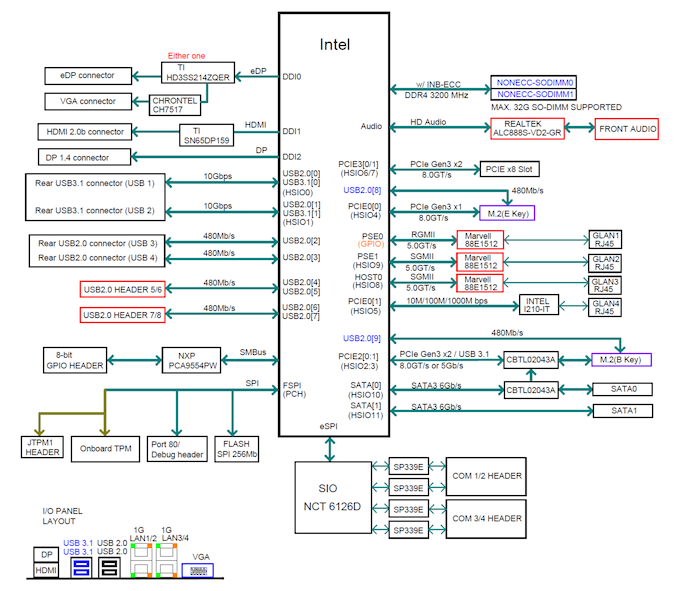Supermicro SYS-E302-12E Fanless Industrial PC Review: Elkhart Lake for IoT Applications
by Ganesh T S on March 10, 2023 8:00 AM EST- Posted in
- Systems
- Fanless
- Supermicro
- Passive Cooling
- Elkhart Lake
Setup Notes and Platform Analysis
Our review sample of the Supermicro SYS-E302-12E came with all necessary components pre-installed - we only had to load up the OS to start our evaluation process. Prior to that, we took some time to look into the BIOS interface. It must be noted that traditional out-of-band management options like a dedicated BMC LAN port or even AMT are not available for the system. The COM ports have some out-of-band management options, but that is quite limited compared to BMC / AMT. Additionally, the board's jumpers are set by default to disable TPM. So, the jumper (JPT1) must be altered to allow Windows 11 to be installed. The BIOS has plenty of other configuration options that are brought out in the video below.
The block diagram below presents the overall high-speed I/O distribution.
Since the Elkhart Lake processor is a SoC, the DMI link details between the internal PCH and the CPU are not readily available. While not much can be commented on the bandwidth allocations due to this, we do see that both USB 2.0 header pairs are brought out as Type-A ports using the thick white cables in the picture below. We also see the COM header pairs getting connected to the RS232 ports.
Access to the internal board is obtained by unscrewing the chassis from the sides and the top and pulling it up. It is necessary to do this in order to install the SODIMMs and M.2 / 2.5" drives in the case of a barebones system.
In today's review, we compare the Supermicro SYS-E302-12E and a host of other systems based on processors with TDPs ranging from 6 W to 35 W. The systems do not target the same market segments, but a few key aspects lie in common, making the comparisons relevant.
| Comparative PC Configurations | ||
| Aspect | Supermicro SYS-E302-12E | |
| CPU | Intel Atom x6425E Elkhart Lake 4C/4T, 2.0 - 3.0 GHz Intel 10, 1.5 MB L2, 12 W |
Intel Atom x6425E Elkhart Lake 4C/4T, 2.0 - 3.0 GHz Intel 10, 1.5 MB L2, 12 W |
| GPU | Intel UHD Graphics for 10th Gen Intel Processors (32EU @ 500 MHz) |
Intel UHD Graphics for 10th Gen Intel Processors (32EU @ 500 MHz) |
| RAM | Innodisk M4SI-AGS1O50K-C DDR4-2666 SODIMM 19-19-19-43 @ 2666 MHz 2x16 GB |
Innodisk M4SI-AGS1O50K-C DDR4-2666 SODIMM 19-19-19-43 @ 2666 MHz 2x16 GB |
| Storage | Innodisk M.2 (S80) 3TE7 DEM28-B56DK1EW1QF (256 GB; M.2 2280 SATA III;) (64L 3D TLC; InnoDisk ID301 Controller) |
Innodisk M.2 (S80) 3TE7 DEM28-B56DK1EW1QF (256 GB; M.2 2280 SATA III;) (64L 3D TLC; InnoDisk ID301 Controller) |
| Wi-Fi | 1x GbE RJ-45 (Intel I210-IT) 3x GbE RJ-45 (Intel EC1000S MAC + Marvell Alaska 88E1512 PHY) |
1x GbE RJ-45 (Intel I210-IT) 3x GbE RJ-45 (Intel EC1000S MAC + Marvell Alaska 88E1512 PHY) |
| Price (in USD, when built) | (Street Pricing on March 9th, 2022) US $894 (Barebones) US $1315 (as configured, no OS) |
(Street Pricing on March 9th, 2022) US $894 (Barebones) US $1315 (as configured, no OS) |
The OnLogic HX500 represents a premium fanless industrial PC with a 35W TDP processor. The Atlas Canyon NUC (based on a Jasper Lake SoC) makes an appearance as a representative of the best possible performance from the Tremont stable, while the Zotac CI331 nano makes up the low end (6W TDP SoC in a fanless configuration). The next few sections will deal with comparative benchmarks for the above systems.












16 Comments
View All Comments
PeachNCream - Monday, March 13, 2023 - link
It was common for OEMs to not actually deliver 75W to a PCIe slot in times past. I'm not as familiar with this stuff now because desktop systems aren't as commonplace, but its always possible to push like 35W to a slot in a space constrained system like that one.Matthias265 - Friday, March 31, 2023 - link
the largest brick Supermicro has is 180Wdeil - Thursday, March 16, 2023 - link
Well, top efficiency is around 75% so it's already 120W, now include all the USB powered devices that come from it, and remember that intel saying 12W means 50W turbo....disable turbo and disconnect all extra devices, and it should run from 30W phone charger.
Matthias265 - Friday, March 31, 2023 - link
hello, yes this necessary for 2 reasons,for the system needs also power fur DRAM, chipset, SSD, USB, PCIe, etc
allowance for the PICe is 65W
also the new CPU have a TPW or 12W, but they draw much higher current during turbo mode,
that's only for a short time, however the power supply must be able to supply 2x to 3x the TDP of the CPU
mode_13h - Saturday, March 11, 2023 - link
I can't help but be disappointed by both the idle & active power. And, in spite of that, it's a little disheartening to see it fall so far behind the N6005.In-band ECC support will be the lone bright spot. However that's coming so late that I'm already looking towards Alder Lake-N.
Hrel - Tuesday, April 11, 2023 - link
A THOUSAND Dollars?! For a computer that couldn't even decode HD video? I could see a use for a system like this but every use case I can imagine couldn't justify more $300 at the absolute max. Who's intended to buy this?